Origami
Origami (折り紙) is the Japanese art of folding paper according to precise patterns, in order to obtain a two-dimensional or three-dimensional paper sculpture that represents people, objects, plants and animals. The paper airplane that you made in elementary school as a child is a very basic example of origami. Different cultures over time have developed a similar tradition, but the Japanese one has perhaps left its mark more than any other, and it is no coincidence that the word origami is now used all over the world.
Introduction and history of origami
The spread of origami in Japan occurred in the centuries following the introduction of paper, brought to the country from China for the first time during the sixth century by Buddhist monks who traveled between the two countries. The first origami forms are traced back to strips of paper folded to create geometric shapes, which, when joined to a wire or a wooden rod, delimited sacred spaces inside Shinto shrines. However, these were very elementary forms.
Starting from the Heian Period (794–1185) and during the Kamakura Period (1185-1333) origami were used in an increasingly elaborate form on numerous occasions. For example, there was the custom among samurai to exchange gifts adorned with
noshi, strips of colored paper folded as a symbol of good luck. During the
Hinamatsuri (Girls' Day), paper dolls were placed on paper boats, which were then left to sail on a river. Or again, during the
Kodomo no hi (Children's Day), children made goat-shaped paper flags and hung them outside the door (this custom still survives today).
However, the first origami book known in Japan,
Senbazuru Orikata, was published in Kyoto only in 1797. Senbazuru means a thousand cranes, while orikata is a word that in ancient Japanese had the same meaning of today's origami. The book included origami drawings, each accompanied by a poem written by the book's author
Gido (1762-1837), the then chief priest of the Choen-ji temple in today's city of Kuwana. When Japan opened its borders in the 1860s, after centuries of isolation, many new ideas came to the country, including the European tradition of paper folding, which had developed autonomously in previous centuries. This specifically included using uncut sheets of paper. Before this period, in fact, in Japan sheets of the most varied shapes and often with cuts were used. In modern Japanese the art of folding and carving paper is called
kirigami (切り紙) , precisely to differentiate it from origami. The difference between an origami work and a kirigami work is therefore that for the second, tools to cut the paper can also be used, while for the first the paper must only be folded.
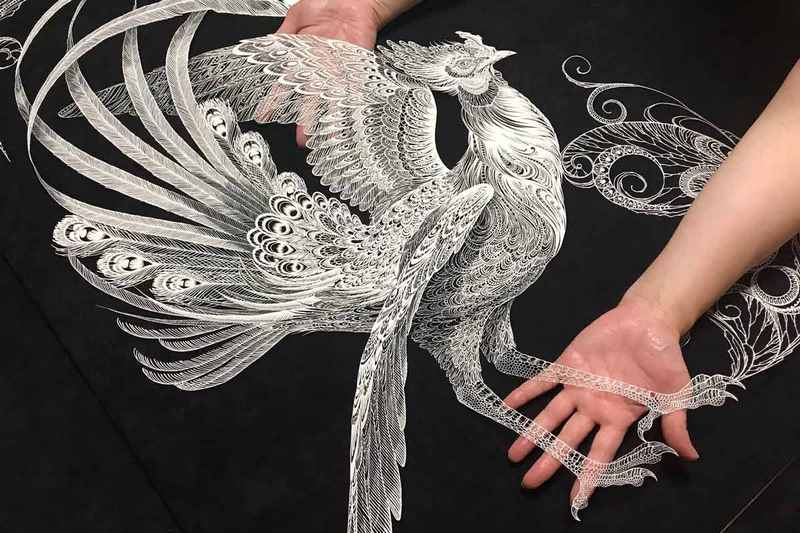 a paper phoenix, an example of a kirigami work
a paper phoenix, an example of a kirigami work
The work of
Akira Yoshizawa (1911-2005) gave vigor to origami during the twentieth century. Yoshizawa was a Japanese artist considered the greatest origami master and an important ambassador of Japanese culture to the world. Yoshizawa has created more than 50 thousand models and was a pioneer of various folding techniques, including "wet-folding", which involves moistening the paper before and during folding. This step is considered by many to be what allowed origami to be equated with an art form, rather than a simple hobby.
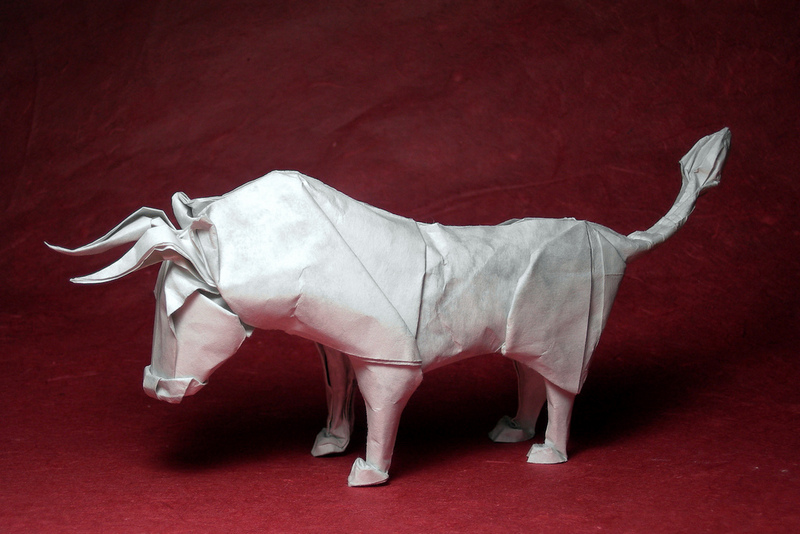 a paper bull made with the "wet-folding" technique
a paper bull made with the "wet-folding" technique
Today the art of origami is widespread all over the world and this word has entered all languages to indicate anything made by folding sheets of paper, without using cuts, glue or marks. In Japan, origami continue to be used on many occasions, for example to make New Year's inaugural cards, for envelopes of money to give to children, for Valentine's Day, and so on.
The paper crane and the story of Sadako Sasaki
One of the most famous origami models is the crane, an auspicious animal in Japanese culture. According to a popular legend, anyone who folds a thousand paper cranes will be able to fulfill his greatest wish. The origami crane (折鶴 orizuru in Japanese) has become a symbol of peace for this belief and because of the sad story of
Sadako Sasaki. Sadako was a Japanese girl from Hiroshima who survived the atomic bomb but was inevitably exposed to radiation. Because of these, in 1955, at the age of twelve, she was dying from leukemia. In the last period of her life, Sadako began folding lots of paper cranes, hoping that in this way her desire to survive would be fulfilled. Today in Hiroshima's
Peace Park there is an important monument dedicated to all the children who died from the atomic bomb. On top of the monument is a statue of a little girl, Sadako Sasaki, holding a crane. Near this monument there are now thousands of origami, which are continually brought by visitors in memory of this moving story.
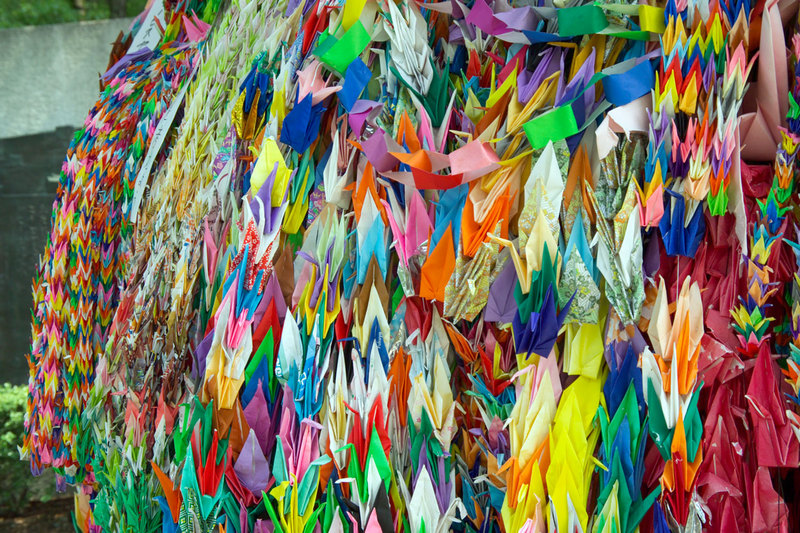 orizuru at Hiroshima Peace Park
orizuru at Hiroshima Peace Park
Origami examples and models
In
this site and in
this other site you can find hundreds of origami models, of all kinds, divided by category and with explanatory photos and instructions to make each of the origami present, step by step.
Where to go to discover the art of origami in Japan

Tokyo Origami Museum, Tokyo
(free admission, opening hours 9:30-17:30)
This small museum is located in the Sumida district of Tokyo, not far from the Tokyo Sky Tree. It is a facility managed by the Nippon Origami Association, where you can find various works created by artists, buy books and other material on the subject and also attend origami lessons (as far as we know only in Japanese).
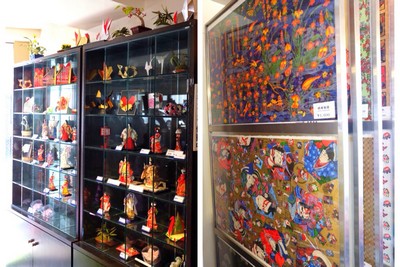
Origami Kaikan, Tokyo
(free admission, opening hours 9:30-16:30)
This center is located in a very central area of Tokyo, near Ochanomizu station and not far from Ueno Park. Here, too, you can view various works on display, buy paper and other origami material and attend lessons, seminars and other events. More information on the official website.
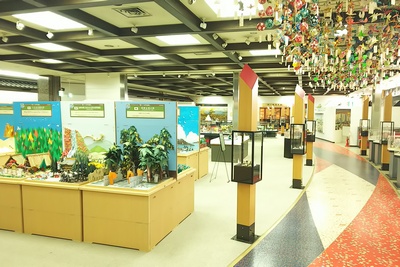
Nippon Origami Museum, Kaga
(admission 500¥, opening hours 9:00-16:30)
The Nippon Origami Museum is the largest museum in the world dedicated to the art of folded paper, with over 100 thousand works on display, many of which have won prestigious awards in origami competitions. Among the most unique, the museum houses the smallest paper crane in the world, which is smaller than the tip of a human hair and must be observed under a microscope. The museum is located in the city of Kaga of the prefecture of Ishikawa, an area little traveled by tourists. It is about an hour by train from the famous city of Kanazawa.
Where to buy origami in Japan
Given that an origami is initially nothing more than a square sheet of paper, many people prefer to use particular types of paper to make their own origami. In Japan you can buy origami paper practically anywhere: in 100 yen shops (such as the Daiso chain), in konbini, supermarkets, stationeries. A nice souvenir from Japan could be an origami paper set or a nice illustrated book with lots of original origami models. In this case, go to one of the large Japanese bookstore chains, such as Kinokuniya and Yurindo.
Guided tours, activities and other things to do
If you are planning a trip to Japan and you want to do something more than just visiting famous places and monuments, we suggest you to use
Rakuten Travel Experiences.
How to use Rakuten Travel Experiences
Rakuten Travel is a very useful website to
enrich your travel experience, especially if you are going solo or it's your first time in Japan.
Because of the language barrier (and more), in Japan it is very difficult to interact with the locals and to get off the tourist track.
Thanks to Rakuten Travel you can find a lot of interesting and sometimes unique
guided tours and activities all over Japan (and not only in Japan), that you would otherwise never be able to enjoy.
But there's more: on Rakuten Travel you can also
buy tickets for several famous attractions, events, transportation and other useful services for tourists. Last but not least, you can
reserve a table in hundreds of restaurants.
Some examples
Take a look at Rakuten Travel Experiences
You may also be interested in


